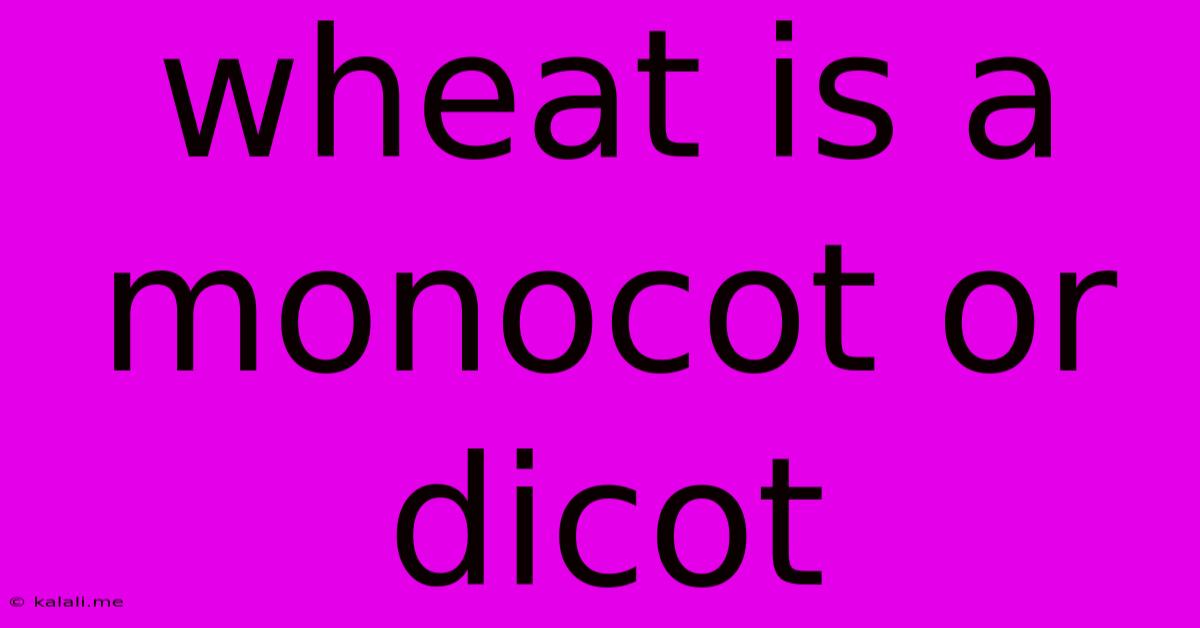Wheat Is A Monocot Or Dicot
Kalali
Jun 13, 2025 · 3 min read

Table of Contents
Wheat: Monocot or Dicot? Understanding Plant Classification
This article will definitively answer the question: Is wheat a monocot or a dicot? We'll explore the characteristics that define these two major groups of flowering plants, and examine why wheat falls firmly into one category. Understanding this classification is crucial for botanists, agricultural scientists, and anyone interested in plant biology. This detailed explanation will also cover related topics such as wheat's evolutionary history and its economic importance.
Wheat is a monocot. This classification is based on several key features observable in its structure and development. Let's delve into the defining characteristics that distinguish monocots from dicots.
Monocots vs. Dicots: Key Differences
The terms "monocot" and "dicot" refer to the number of cotyledons, or embryonic leaves, present in the seed. However, this is just one of many differences between these two groups. Here's a comparison:
Monocots:
- One cotyledon: The seed possesses only one embryonic leaf.
- Parallel leaf venation: Leaf veins run parallel to each other.
- Flower parts in multiples of three: Petals, sepals, and stamens are typically arranged in threes or multiples of three.
- Fibrous root system: The root system is composed of numerous thin roots.
- Scattered vascular bundles: Vascular bundles (xylem and phloem) are scattered throughout the stem.
Dicots:
- Two cotyledons: The seed contains two embryonic leaves.
- Reticulate leaf venation: Leaf veins form a network pattern.
- Flower parts in multiples of four or five: Flower parts are typically arranged in fours or fives.
- Taproot system: The root system has a main taproot with smaller lateral roots branching off.
- Vascular bundles arranged in a ring: Vascular bundles are arranged in a ring within the stem.
Why Wheat is a Monocot
Wheat clearly exhibits all the characteristics of a monocot:
- Single cotyledon: A wheat seed contains a single cotyledon, providing nourishment to the developing seedling.
- Parallel venation: Wheat leaves have distinctive parallel veins.
- Flowers in multiples of three: Wheat flowers have floral parts arranged in multiples of three.
- Fibrous root system: Wheat plants develop a fibrous root system.
- Scattered vascular bundles: The vascular bundles in wheat stems are scattered.
The Significance of Wheat Classification
Knowing that wheat is a monocot is important for several reasons:
- Agricultural practices: Understanding wheat's biology informs planting techniques, fertilization strategies, and pest management.
- Genetic research: Classification helps researchers understand wheat's evolutionary relationships and facilitates genetic studies.
- Crop improvement: Knowing its place in the plant kingdom helps scientists develop improved wheat varieties.
Beyond the Basics: Wheat's Evolutionary History and Economic Importance
Wheat ( Triticum species) belongs to the Poaceae family, also known as the grass family. This family includes many other economically important cereal crops like rice, corn, and barley. Wheat's evolutionary history is complex, involving hybridization and polyploidy (having more than two sets of chromosomes). This has contributed to its genetic diversity and adaptability.
Wheat is a staple food crop globally, providing essential carbohydrates for billions of people. Its economic importance is immense, impacting food security, trade, and global economies.
In conclusion, the answer is clear: wheat is unequivocally a monocot. Understanding this classification provides valuable insights into its biology, cultivation, and significance in the global food system.
Latest Posts
Latest Posts
-
Lcm Of 6 7 And 9
Jun 14, 2025
-
Can I Change My Sat Date
Jun 14, 2025
-
Oxidation Number Of Cr2 In K2cr2o7
Jun 14, 2025
-
Group Of Words That Express A Complete Idea
Jun 14, 2025
-
An Artesian Well Is One In Which
Jun 14, 2025
Related Post
Thank you for visiting our website which covers about Wheat Is A Monocot Or Dicot . We hope the information provided has been useful to you. Feel free to contact us if you have any questions or need further assistance. See you next time and don't miss to bookmark.